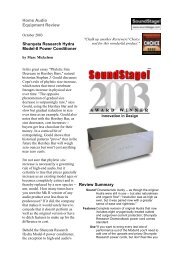Download Model 5 brochure
Download Model 5 brochure
Download Model 5 brochure
Create successful ePaper yourself
Turn your PDF publications into a flip-book with our unique Google optimized e-Paper software.
stage we managed to eliminate, we reduced the<br />
distortions of the transistors and increased the linear<br />
bandwidth of the circuitry,” explains Matthias<br />
Ruff. The MODEL5 achieves bandwidth of more<br />
than 220 kHz. This is practically four octaves above<br />
the frequency response of a CD. Even the high<br />
resolutions of modern recording technologies like<br />
SACD and Super AUDIO DVD are handled with<br />
ease. The MODEL5 is so fast that even highest frequencies<br />
above the audio spectrum are amplified<br />
linearly. “The faster the forward signal is processed,<br />
the higher the frequencies of the feedback distortions<br />
occur. With the MODEL5 these problems are practically<br />
immeasurable and far beyond the audio<br />
range,” describes Matthias Ruff.<br />
LOCAL LINEARISATION<br />
Another disadvantage of an OVERALL LOOP<br />
FEEDBACK is that it is not the cause of a problem<br />
but only the result of a problem when corrected. A<br />
distortion generated in the second stage of the amplifier<br />
is not being eliminated at the point of origin,<br />
but only at the end as the sum of all stages. Not the<br />
actual reason but only the symptoms are being fixed.<br />
Matthias Ruff gives us a simple example which<br />
explains this correlation more easily: “Just imagine<br />
you put on some shoes which are too small. After a<br />
while you get blisters on your feet. A lotion and<br />
band-aid will now alleviate the symptoms but not<br />
the cause! If you have a better and faster feedback<br />
from your feet, you would have immediately put on<br />
some bigger shoes. The problem would have been<br />
solved and the blisters would not have developed.”<br />
MINIMAL Single Stage FEEDBACK<br />
Nevertheless Avantgarde Acoustic did not want to<br />
completely abandon the effective OVERALL LOOP<br />
FEEDBACK. Matthias Ruff has a clear point of view<br />
in this matter: “People normally only see black or<br />
white. Mostly the feedback applied is completely<br />
‘over the top’ or left out totally as in ZERO FEED-<br />
BACK designs. Both solutions have many disadvantages.<br />
For me the happy medium is the best solution”.<br />
The percentage of distortions generated by the<br />
MODEL5 itself are inherently small in comparison<br />
to normal amplifiers, as it only has two transistors<br />
in the signal path, which are even linearised independently<br />
by special circuits. For this reason the<br />
OVERALL LOOP FEEDBACK can be applied very<br />
carefully. According to the manufacturer only the<br />
large distortions of the circuitry are equalized.<br />
“I purposely do without strong feedback only to get<br />
good specifications. If you take into consideration<br />
that normal speakers produce higher distortions<br />
(by approximately 10%) than amplifiers, you can<br />
see that amplifier distortions are highly overrated”.<br />
The designer emphasizes that he has chosen maximum<br />
resolution in practical operations instead of<br />
optimising for negligible technical specifications.<br />
The main objective is to make the amplifier as fast<br />
as possible so that even the finest details of music<br />
are reproduced accurately.<br />
This example makes the biggest disadvantage of a<br />
high OVERALL LOOP FEEDBACK in multi stage<br />
amplifier designs more obvious: a mistake occurs,<br />
after some time it develops into a problem and only<br />
than is cured. “The most important thing is to detect<br />
the defect immediately at its point of origin. If you<br />
than know what’s going wrong, you have to treat<br />
the cause precisely and the treatment must solve the<br />
problem quickly”. According to Matthias Ruff the<br />
key to success is a local linearisation concept. For<br />
this reason both amplification stages of the MODEL5<br />
are linearised separately. The BI-POLAR driver stage<br />
as well as the MOS-FET power transistors have<br />
their own linearisation circuitry. Each deviation is<br />
detected at the point of origin and immediately<br />
linearised, independent of the adjacent stage. “We<br />
are working with automatically self-smoothing subsystems<br />
which autonomously do their work and<br />
efficiently reduce distortions”.<br />
But how does the MODEL5 with its relatively low<br />
feedback behave on complex loads? “The more<br />
amplification stages one is using, the slower the<br />
circuit is and the more negative the EMF forces


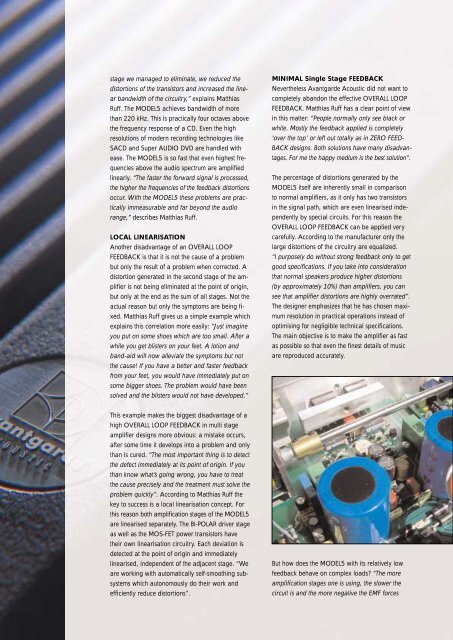
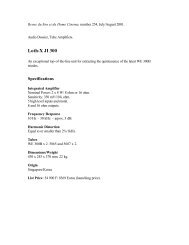


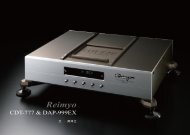

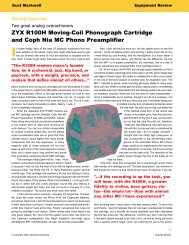
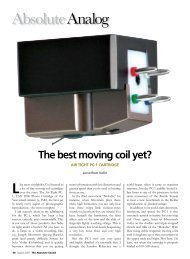
![DAP-999 EX Limited [pdf] - Audio Note Singapore](https://img.yumpu.com/27191044/1/190x253/dap-999-ex-limited-pdf-audio-note-singapore.jpg?quality=85)

![Harmonix CS-120 Improved-Version [pdf]](https://img.yumpu.com/24411255/1/184x260/harmonix-cs-120-improved-version-pdf.jpg?quality=85)
